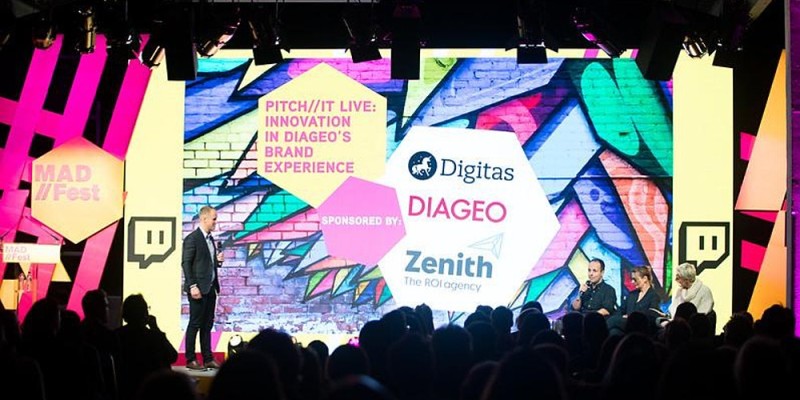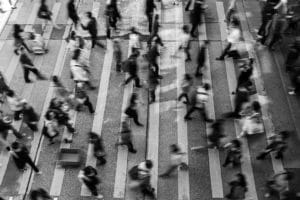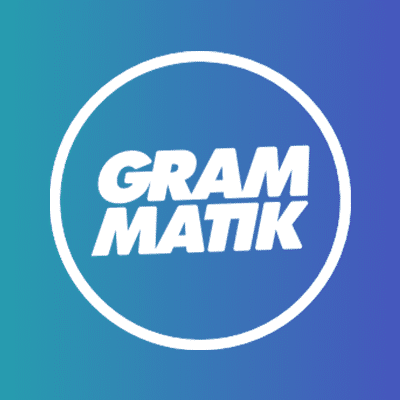
Recently we saw some of the biggest and brightest brands active in this space assemble in London for MADFest, to impress and gently provoke with slick presentations on the tech developments that have been bubbling away behind closed doors while we’ve all been cooped up at home. And they certainly didn’t disappoint.

The most memorable advocate for AI in marketing I listened to was Stefan Britton, Commercial Director at Datasine. Their innovation is to use AI to drastically improve the performance of paid media campaigns, so you get a lot more bang for your buck. They do this by plugging into your platform and leveraging AI muscle to make suggestions and improvements to the creative that is more likely to resonate with the audience, and to secure that sweet conversion.
The tech is startlingly clever, capable of analysing images across a lot of very specific parameters, and drawing conclusions on the combination that works best. It takes lots of real data, and applies a hurricane of computing power to analyse in seconds what would take an army of data scientists armed with spreadsheets and market research surveys quite a long time.
The rationale is undeniable; why pay to test out creative that may not work when you can optimise this prior to launching the campaign, only using creative that connects? In a market now so grossly oversaturated by the pandemic fuelled acceleration of digital advertising, average costs for getting your ad seen have skyrocketed. Can you afford to pay to see what doesn’t work?
The numbers Britton used to support his argument were similarly disarming, highlighting our industry has a bit of a dirty secret. Roughly 80% of ROI is driven by creative yet 96% of ads are forgotten, which means a lot of money is being spent on stuff that doesn’t work. Consumers are drowning in ads, in the UK we’re exposed to up to 10k per day rising to 17k in the US. Our brains decide in milliseconds if what we’re looking at deserves our attention, and if given the green light, an average of 1.7 seconds is all it takes to form a staunch opinion before our brain hurries off in search of the next stimulus.
Studies show the type of AI in marketing that Britton champions can help grab the attention of target audiences better than we seasoned professionals. Is this not a well laid path to bland homogeneity where nothing new or different is needed as it just doesn’t perform as well as the computer?
Another voice that caught my ear at MADFest was Tony Davidson, Executive Creative Director at Weiden&Kennedy. Ever the consummate creative and industry stalwart, Davidson gave a very punchy and insightful speech rattling through his top 20 tips from 20 years at W&K. Despite not explicitly agreeing with my fear that AI in marketing may trigger a putting out to pasture for creatives and novel thinking, not one of his pearls of wisdom had anything to do with technology, which I felt spoke volumes. Almost every one of his tips for massaging an agency into a shape that can help brands move mountains boiled down to one thing. People.

Creativity needs cultivation. The ground one prepares for people to do their best work must be carefully fertilised with the nutrients required for explosive imagineering. Passion, community, diversity, freedom of thought, regular sources of inspiration, a supportive culture – these are the ingredients needed to get people to do work that grabs our attention, and sticks in our memory.
Davidson encouraged the audience to step outside of their comfort zone and engage with people away from their circle of influence, to celebrate the quirks and the weird, wonderful foolishness of being silly and frivolous for the sake of it. It doesn’t have to make sense, or be driven by numbers. Success is measured not by the KPIs computers interpolate, but whether the work has impacted our lives and left an imprint on the fabric of our culture.
One of Davidson’s points was to suggest design shouldn’t be an afterthought; it comes first, and should lead the process. Giving creatives, be it marketeers or graphic designers, the reassurance to trust one’s gut and spend time on crafting work is a big call, when the reality is that budgets are tight, and businesses, brands, careers and livelihoods rest on the success of a precariously balanced, and increasingly impatient fickle variable. Us, the consumers.
Leading the charge for the middle ground came Laura Jordan Bambach, Chief Creative Officer and President of Grey London. Bambach astutely called it for what it is; we’ve relied too much on tech at creativity’s expense and have now got to the point where we think these things are in competition. Being able to measure performance is great and has served us well in many respects, but can become a bit of a trap where we chase stats above all else.

Bombach offered an example of a current use of AI in marketing in the form of photorealistic AI rendered virtual production starting to replace some remote commercial shoots at WPP, and other clever tech like motion tracking cameras pointed at swarms of bats triggering audio to create experiential soundscapes for Bacardi. The thread woven throughout was that those tasked with generating the creative were empowered to use tech as a tool but not be led by it, vying to achieve something meaningful outside the humdrum everyday stuff clogging our screens we’re so quick to forget.
For those looking to make an impact and be heard above the roar, it’s clear from all sides it starts and stops with the creative decisions we place at the centre of campaigns. Some brands might not have the luxury of a tuned-in creative agency to spend time on their work, and it sits with an already stretched marketing and comms department trying to make the best of a hand they’ve been dealt. Conversely, there may be some brands already doing so well they don’t need to optimise everything to the nth degree, and can afford to make fewer, better, riskier, memorable campaigns adding more to our culture than they take away, crucially putting jobs and work in the hands of creatives, not computers.
I can’t begrudge a business trying to use the tools available to them to further their brand amidst really difficult market conditions, and the use of AI in marketing may help some who otherwise couldn’t compete financially. I hope, as an industry, and as a wider culture, we don’t slip unwittingly into the abyss where more and more decisions are made for us, especially creative ones. History and our most celebrated science fiction only goes to show what happens when large groups of people all of a sudden stop challenging, speaking out, doing things differently and start to apathetically conform.
Computers are only ever going to show us a reorganisation of data we arm it with, according to principles and laws a tiny minority dictate. People’s capacity to surprise, shock and delight knows no bounds and that’s who I’d prefer to sit down with and discuss the creative on my client’s next campaign. Even if it means having to explain to them why it didn’t do as well as the computer!
For more info on Madfest, visit their website.
Have you got a creative project you’d like to discuss? Send Mischa an email.

©️2024 Grammatik Agency, Second Home, 125–127 Mare St, London E8 3SJ.
[email protected]
+44 (0)20 3950 7057 Privacy policy